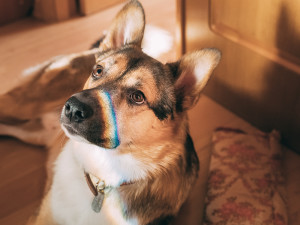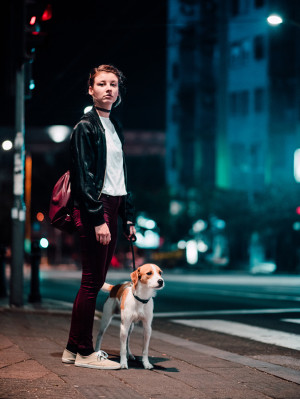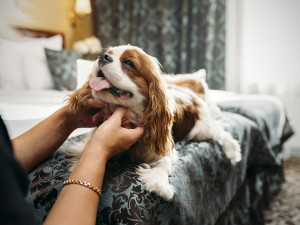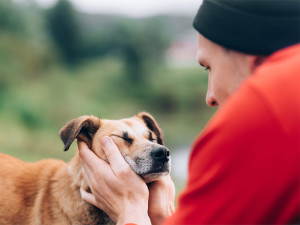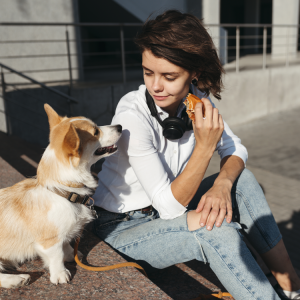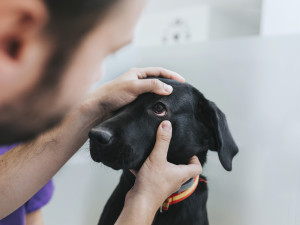Can Dogs See in the Dark? Does My Dog Have Night Vision?
Hopefully, they at least fare better than we do when the lights go out.

Share Article
In This Article:
Should I Leave the Light On For My Dog? How Well Can Dogs See In The Dark? Can Dogs See In The Dark Better Than Humans? Why Do Dogs’ Eyes Glow In The Dark?
Do you ever walk into a dark room in the middle of the night and see two glowing orbs staring back at you? If you’ve just watched a horror movie, you likely jump out of your pajamas. But once you remember your dog is in the same room, you allow yourself to take a few deep breaths before walking over for a snuggle. Your pup just gave you a jump scare, but did they actually even see you? Can dogs see in the dark?
Main takeaways
Dogs have a remarkable ability to see in low light, even in situations where people would consider it completely dark.
In addition to having good low-light vision, dogs possess other heightened senses which aid them in navigating in the dark.
Dogs can see better in the dark than humans, but not quite as well as cats.
The “glow” from dogs’ eyes comes from a reflective layer in their eyes that helps improve night vision.
Should I leave the light on for my dog?
I know my dogs can see better than I can in the dark, but does leaving a light on help them get around? They seem to manage OK without it, but maybe I’m causing them unnecessary stress by leaving them in the dark. Do dogs have night vision? What do dogs see in the dark?
Many pet parents fret over how much light their dog needs to navigate obstacles comfortably. Dogs don’t require much light to get around, but providing some soft lighting can help them see more easily. This is especially true for dogs that have impaired vision due to cataracts, corneal scarring, or other eye issues.

How well can dogs see in the dark?
Dogs have adapted over time to be able to see well in low-light situations. Dogs cannot see anything in total darkness — no animal can see without light — but they still maintain vision when it might seem impossibly dark to a person.
Following the path of light as it enters a dog’s eye can help you to understand how they see and what adaptations have helped improve their night vision. As light enters a dog’s eye, it encounters the following structures:
Cornea: The clear surface of the eye is actually a very specialized version of epithelium (or skin). Its large size and domed surface allow light to enter from different angles. Many of the most common eye problems in dogs originate here.
Anterior chamber: This area in the front of the eye is filled with aqueous humor, a clear liquid that allows light to pass through. This liquid exerts pressure on the cornea and helps give the eye its shape. Inflammation in this chamber can reduce that pressure.
Pupil: The size of this open space is controlled by the iris, which dilates or contracts to allow more or less light in. The pupil gets larger in low-light conditions so that the amount of incoming light is maximized.
Lens: This clear disc allows light to pass into the back half of the eye. It can change shape to focus the light on the very back of the eye, where the light-sensing tissues are. Cataracts develop here and decrease the amount of light entering the back of the eye.
Posterior chamber: The back part of the eye is filled with clear, jelly-like vitreous humor. This also helps maintain the shape of the eye and carries nutrition to some of the tissues of the eye.
Retina: This is where the magic happens. The retina is covered in rods and cones, which are specialized light receptors. Rods are great at picking up very faint light but don’t provide great visual detail. Cones need more light to function but are better at delivering information about color and fine detail.
Tapetum lucidum: Sitting behind the sensory cells of the retina, the reflective tapetum lucidum bounces light that was not picked up by a rod or cone back at those cells for a second chance at activating them.
Now that you understand how dogs’ vision works, it’s easier to spot the different adaptations that improve their night vision. A dog’s cornea occupies a much larger area of the eye’s surface than people’s, allowing more light to enter. Their pupils can open wider as well, meaning that more of the light that enters is transmitted to the retina.
A dog’s retina has a higher proportion of rods than cones, giving priority to low-light vision. These rods are also located in the area of the retina that is most likely to be hit by light, increasing the chance that they will be activated. The tapetum lucidum reflects the light that’s missed by the rods and cones back at them, improving low-light vision.
So, the answer to “Can dogs see well in the dark?” is a resounding “Yes!” Their eyes evolved to prioritize tracking fast-moving objects in a variety of lighting situations. This improved reaction time and performance in low light comes at a cost though. Dogs see far fewer color varieties than people do, and their vision is much less sharp than ours.
Can dogs see in the dark better than humans?
Dogs have superior vision to humans in the dark. This is because people’s eyes have some key differences from dogs’ eyes, such as:
Smaller corneas
Smaller pupils
Relatively more cones than rods
Increased cone density in the focal area
No tapetum lucidum
These differences make it harder for people to see in the dark. Humans do have some advantages, though: we’re able to see more colors and visualize objects in more detail — as long as there’s enough light for us to see. Dogs don’t rely on vision as their primary way of experiencing the world, so visual acuity isn’t as important to them. Their sense of smell goes well beyond what people can imagine, and dogs use sight as a way to supplement what they’re picking up through smell.
What colors can dogs see in the dark?
It’s not known for sure what colors dogs can see in the dark, but it’s likely that their low-light vision is not very colorful because of the relatively high numbers of rods providing visual information. Cones, which are responsible for color vision, require several hundred times the amount of light to activate than rods do. In very low-light situations, dogs likely see primarily in grayscale.
A common question vets get is “What do dogs see when they look at the world?” It’s hard to know how exactly each species processes their vision. In light, dogs likely see things primarily in shades of blue and yellow, which are the colors their cones can detect best. This type of color vision is similar to that of a person with red-green colorblindness.
Because of the preponderance of rods and the presence of the tapetum lucidum, dogs’ vision has less acuity than people’s. It’s estimated that they have 20:70 vision in the best-case scenario, meaning that they see an object twenty feet away with the same level of detail a person with normal vision would see it at seventy feet away.
Can dogs see in the dark like cats?
Dogs can see in the dark, but cats have even better vision in the dark than dogs do. The tapetum lucidum in a cat’s eye covers more area and is more reflective than a dog’s. As crepuscular animals, cats’ eyes evolved to allow them to hunt best at dawn and dusk, when light levels are low.
So, how well can dogs see in the dark overall? Dogs’ night vision falls between that of cats and humans, allowing them some advantages over cats in full light, but some disadvantages in low light. Both dogs and cats see better in the dark than people do. It’s likely that your dog is very confused about why you didn’t see that table you stubbed your toe on when you’re stumbling around at night.
Cats can see details in environments six times darker than those that appear completely black to humans. Dogs land somewhere in the middle, possessing night vision superior to ours but not quite matching the impressive capabilities of felines. Dogs evolved the ability to see well under low-light conditions but maintained solid daylight vision as well. This gives them the ability to track objects in most natural conditions, so they are not limited to hunting during a particular time of day.
Why do dogs’ eyes glow in the dark?
Most dog parents have seen their dog’s eyes seeming to light up in a dark room or during a nighttime walk. Dogs’ eyes don’t produce their own light — they don’t truly glow in the dark — but they’re good at reflecting what little light is available. The tapetum lucidum reflects light that wasn’t absorbed by the sensory cells of the retina back at those cells to give the photons a second chance at being absorbed.
Whatever light isn’t caught on this second go-round continues through the eye to the lens, where it is refracted, giving it an eerie glow. This glow is often yellow to greenish, which is the color of the tapetum in older dogs. Puppies often have a more bluish tapetum that changes color as they mature.
Final thoughts
Although broadly very similar in structure, dog and human eyes have some key differences that allow dogs to maintain sight in many types of light. While their vision may not be the sharpest or most vibrant, it allows dogs to function in much lower light levels than people can. Combined with their superior sense of smell, dogs’ sight allows them to navigate in dark environments with little issue.
References
Byosiere, Sarah-Elizabeth, et al. “What Do Dogs (Canis Familiaris) See? A Review of Vision in Dogs and Implications for Cognition Research.” Psychonomic Bulletin & Review, vol. 25, no. 5, 15 Nov. 2017, pp. 1798–1813, link.springer.com/article/10.3758/s13423-017-1404-7opens in new tab, https://doi.org/10.3758/s13423-017-1404-7opens in new tab.
Donisa, Alina, et al. Dynamics of the Normal Aspect of Tapetum Lucidum at Dogs Regarding Age. Jan. 2009, www.researchgate.net/publication/228883807_Dynamics_of_the_normal_aspect_of_tapetum_lucidum_at_dogs_regarding_ageopens in new tab.
“Eye Structure and Function in Dogs - Dog Owners.” Veterinary Manual, www.msdvetmanual.com/dog-owners/eye-disorders-of-dogs/eye-structure-and-function-in-dogsopens in new tab.
Kawamura, Satoru, and Shuji Tachibanaki. “Explaining the Functional Differences of Rods versus Cones.” Wiley Interdisciplinary Reviews: Membrane Transport and Signaling, vol. 1, no. 5, 14 Feb. 2012, pp. 675–683, https://doi.org/10.1002/wmts.8opens in new tab.
Miller, P. E., and C. J. Murphy. “Vision in Dogs.” Journal of the American Veterinary Medical Association, vol. 207, no. 12, 15 Dec. 1995, pp. 1623–1634, pubmed.ncbi.nlm.nih.gov/7493905/opens in new tab.
Yamaue, Yasuhiro, et al. “Spatial Relationships among the Cellular Tapetum, Visual Streak and Rod Density in Dogs.” Journal of Veterinary Medical Science, vol. 77, no. 2, 2015, pp. 175–179, https://doi.org/10.1292/jvms.14-0447. Accessed 16 Nov. 2022opens in new tab.
Yasuhiro Yamaue, et al. “Macroscopic and Histological Variations in the Cellular Tapetum in Dogs.” Journal of Veterinary Medical Science, vol. 76, no. 8, 1 Jan. 2014, pp. 1099–1103, https://doi.org/10.1292/jvms.14-0132opens in new tab. Accessed 21 Nov. 2023.

Dr. Bartley Harrison, DVM
Dr. Bartley Harrison is a veterinarian with more than 19 years of experience. He has treated a variety of species in emergency and speciality practices for both large and small animals. His primary interests as a vet are emergency medicine and critical care.
Related articles
![a dog walking with their parent at night]()
Why Do Dogs’ Eyes Glow in the Dark?
The reason for your midnight jump-scare? Turns out it’s just your dog’s spooky eyes.
![Cavalier King Charles Spaniel's eye is examined on the bed by a person]()
Dogs Get Dry Eye Too...Some Breeds More Than Others
Eyes without tears are only for Cameron Diaz in The Holiday.
![A man holding a dogs face in his hands.]()
How to Manage Eye Inflammation in Dogs
This natural remedy may prove to be a key for managing symptoms without side effects.
![corgi giving woman puppy dog eyes begging for food]()
A New Study Debunks the Theory That “Puppy Dog Eyes” Are for Humans’ Benefit
Apparently wild dogs can be pretty cute, too.
![Cavalier King Charles Spaniel's eye is examined on the bed by a person]()
Dogs Get Dry Eye Too...Some Breeds More Than Others
Eyes without tears are only for Cameron Diaz in The Holiday.
Cherry Eye in Dogs: Why Is Your Dog’s Eye So Red?
That would be a cherry eye, and you’ll want to see your vet.
